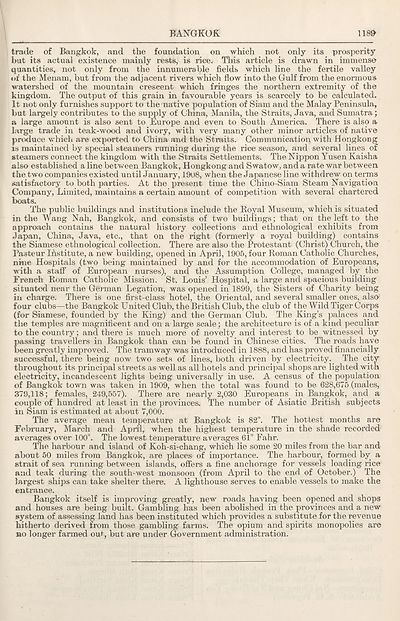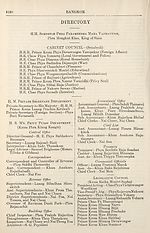1917
(1302) Page 1189
Download files
Complete book:
Individual page:
Thumbnail gallery: Grid view | List view

BANGKOK
trade of Bangkok, and the foundation on which not only its prosperity
but its actual existence mainly rests, is rice. This article is drawn in immense
quantities, not only from the innumerable fields which line the fertile valley
of the Menam, but from the adjacent rivers which flow into the Gulf from the enormous
watershed of the mountain crescent which fringes the northern extremity of the
kingdom. The output of this grain in favourable years is scarcely to be calculated.
It not only furnishes support to the native population of Siam and the Malay Peninsula,
but largely contributes to the supply of China, Manila, the Straits, Java, and Sumatra;
a large amount is also sent to Europe and even to South America. There is also a
large trade in teak-wood and ivory, with very many other minor articles of native
produce which are exported to China and the Straits. Communication with Hongkong
is maintained by special steamers running during the rice season, and several lines of
steamers connect the kingdom with the Straits Settlements. The Nippon Yusen Kaisha
also established a line between Bangkok, Hongkong and Swatow, and a rate war between
the two companies existed until January, 1908, when the Japanese line withdrew on terms
satisfactory to both parties. At the present time the Chino-Siam Steam Navigation
Company, Limited, maintains a certain amount of competition with several chartered
boats.
The public buildings and institutions include the Royal Museum, which is situated
in the Wang Nah, Bangkok, and consists of two buildings; that on the left to the
approach contains the natural history collections and ethnological exhibits from
Japan, China, Java, etc., that on the right (formerly a royal building) contains
the Siamese ethnological collection. There are also the Protestant (Christ) Church, the
Pasteur lAstitute, a new building, opened in April, 1905, four Roman Catholic Churches,
nine Hospitals (two being maintained by and for the accommodation of Europeans,
with a staff of European nurses), and the Assumption College, managed by the
French Roman Catholic Mission. St. Louis’ Hospital, a large and spacious building
situated near the German Legation, was opened in 1899, the Sisters of Charity being
in charge. There is one first-class hotel, the Oriental, and several smaller ones, also
four clubs—the Bangkok United Club, the British Club, the club of the Wild Tiger Corps
(for Siamese, founded by the King) and the German Club. The King’s palaces and
the temples are magnificent and on a large scale; the architecture is of a kind peculiar
to the country; and there is much more of novelty and interest to be witnessed by
passing travellers in Bangkok than can be found in Chinese cities. The roads have
been greatly improved. The tramway was introduced in 1888, and has proved financially
successful, there being now two sets of lines, both driven by electricity. The citv
throughout its principal streets as well as all hotels and principal shops are lighted with
electricity, incandescent lights being universally in use. A census of the population
of Bangkok town was taken in 1909, when the total was found to be 628,675 (males,
379,118; females, 249,557). There are nearly 2,030 Europeans in Bangkok, and a
couple of hundred at least in the provinces. The number of Asiatic British subjects
in Siam is estimated at about 7,000.
The average mean temperature at Bangkok is 82°. The hottest months are
February, March and April, when the highest temperature in the shade recorded
averages over 100°. The lowest temperature aver ages 61° Fahr.
The harbour and island of Koh-si-chang, which lie some 20 miles from the bar and
about 50 miles from Bangkok, are places of importance. The harbour, formed by a
strait of sea running between islands, offers a fine anchorage for vessels loading rice
and teak during the south-west monsoon (from April to the end of October.) The
largest ships can take shelter there. A lighthouse serves to enable vessels to make the
entrance.
Bangkok itself is improving greatly, new roads having been opened and shops
and houses are being built. Gambling has been abolished in the provinces and a new
system of assessing land has been instituted which provides a substitute for the revenue
hitherto derived from those gambling farms. The opium and spirits monopolies are
no longer farmed out, but are under Government administration.
trade of Bangkok, and the foundation on which not only its prosperity
but its actual existence mainly rests, is rice. This article is drawn in immense
quantities, not only from the innumerable fields which line the fertile valley
of the Menam, but from the adjacent rivers which flow into the Gulf from the enormous
watershed of the mountain crescent which fringes the northern extremity of the
kingdom. The output of this grain in favourable years is scarcely to be calculated.
It not only furnishes support to the native population of Siam and the Malay Peninsula,
but largely contributes to the supply of China, Manila, the Straits, Java, and Sumatra;
a large amount is also sent to Europe and even to South America. There is also a
large trade in teak-wood and ivory, with very many other minor articles of native
produce which are exported to China and the Straits. Communication with Hongkong
is maintained by special steamers running during the rice season, and several lines of
steamers connect the kingdom with the Straits Settlements. The Nippon Yusen Kaisha
also established a line between Bangkok, Hongkong and Swatow, and a rate war between
the two companies existed until January, 1908, when the Japanese line withdrew on terms
satisfactory to both parties. At the present time the Chino-Siam Steam Navigation
Company, Limited, maintains a certain amount of competition with several chartered
boats.
The public buildings and institutions include the Royal Museum, which is situated
in the Wang Nah, Bangkok, and consists of two buildings; that on the left to the
approach contains the natural history collections and ethnological exhibits from
Japan, China, Java, etc., that on the right (formerly a royal building) contains
the Siamese ethnological collection. There are also the Protestant (Christ) Church, the
Pasteur lAstitute, a new building, opened in April, 1905, four Roman Catholic Churches,
nine Hospitals (two being maintained by and for the accommodation of Europeans,
with a staff of European nurses), and the Assumption College, managed by the
French Roman Catholic Mission. St. Louis’ Hospital, a large and spacious building
situated near the German Legation, was opened in 1899, the Sisters of Charity being
in charge. There is one first-class hotel, the Oriental, and several smaller ones, also
four clubs—the Bangkok United Club, the British Club, the club of the Wild Tiger Corps
(for Siamese, founded by the King) and the German Club. The King’s palaces and
the temples are magnificent and on a large scale; the architecture is of a kind peculiar
to the country; and there is much more of novelty and interest to be witnessed by
passing travellers in Bangkok than can be found in Chinese cities. The roads have
been greatly improved. The tramway was introduced in 1888, and has proved financially
successful, there being now two sets of lines, both driven by electricity. The citv
throughout its principal streets as well as all hotels and principal shops are lighted with
electricity, incandescent lights being universally in use. A census of the population
of Bangkok town was taken in 1909, when the total was found to be 628,675 (males,
379,118; females, 249,557). There are nearly 2,030 Europeans in Bangkok, and a
couple of hundred at least in the provinces. The number of Asiatic British subjects
in Siam is estimated at about 7,000.
The average mean temperature at Bangkok is 82°. The hottest months are
February, March and April, when the highest temperature in the shade recorded
averages over 100°. The lowest temperature aver ages 61° Fahr.
The harbour and island of Koh-si-chang, which lie some 20 miles from the bar and
about 50 miles from Bangkok, are places of importance. The harbour, formed by a
strait of sea running between islands, offers a fine anchorage for vessels loading rice
and teak during the south-west monsoon (from April to the end of October.) The
largest ships can take shelter there. A lighthouse serves to enable vessels to make the
entrance.
Bangkok itself is improving greatly, new roads having been opened and shops
and houses are being built. Gambling has been abolished in the provinces and a new
system of assessing land has been instituted which provides a substitute for the revenue
hitherto derived from those gambling farms. The opium and spirits monopolies are
no longer farmed out, but are under Government administration.
Set display mode to:
![]() Universal Viewer |
Universal Viewer | ![]() Mirador |
Large image | Transcription
Mirador |
Large image | Transcription
Images and transcriptions on this page, including medium image downloads, may be used under the Creative Commons Attribution 4.0 International Licence unless otherwise stated. ![]()
| Asian directories and chronicles > 1917 > (1302) Page 1189 |
|---|
| Permanent URL | https://digital.nls.uk/194549234 |
|---|
| Attribution and copyright: |
|
|---|---|
| Description | Volumes from the Asian 'Directory and Chronicle' series covering 1917-1941, but missing 1919 and 1923. Compiled annually from a multiplicity of local sources and research. They provide listings of each country's active corporations, foreign residents and government agencies of all nationalities for that year, together with their addresses. Content includes: various treaties; coverage of conflicts; currencies and taxes; consular fees; weights and measures; public holidays; festivals and traditions. A source of information for both Western states and communities of foreigners living in Asia. Published by Hongkong Daily Press. |
|---|---|
| Shelfmark | H3.86.1303 |
| Additional NLS resources: |

